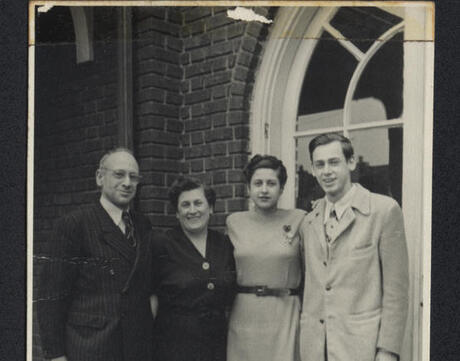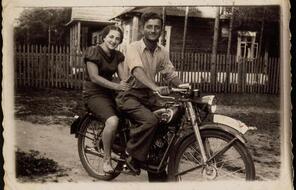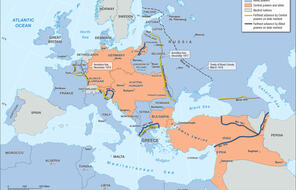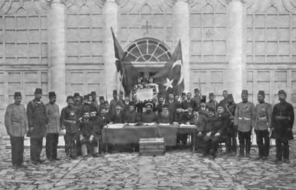Immigrating to the United States was not a simple process in the 1930s. It required clearing many bureaucratic hurdles as well as having personal connections, good timing, and a certain amount of luck. Potential immigrants to the United States had to collect many types of documents, including proof of identity, police certificates, medical clearances, tax documents, a ship ticket, and exit permits, prior to obtaining a visa. Most also had to find an American financial sponsor who had the resources to guarantee that they would never become a burden on the United States. This was often the most difficult obstacle to overcome, since the German government established severe taxes—in effect, taking the majority of an emigrant’s net worth—prior to granting permission to leave the country. The financial sponsor had to submit tax returns, bank statements, and employer letters to prove they could support an immigrant so that immigrant would never become a “public charge” (immigration officials used this term to refer to a person who was considered primarily dependent on public or private welfare).
The US government made no exceptions for refugees escaping persecution, and it did not adjust the immigration laws during the refugee crisis of the 1930s and 1940s. As a result, the waiting lists for US immigrant visas grew as hundreds of thousands of Jews attempted to flee Europe. When the United States entered World War II, it became more challenging for Jews to escape. The State Department instituted additional restrictions on immigration in 1941, citing national security concerns. Among these was the announcement that any refugee with close family still in enemy territory would be ineligible for a US immigration visa. American consulates in Nazi-occupied territory closed in July 1941, cutting off many applicants from the US diplomats who could issue visas. At the same time, the State Department announced that all visa applicants had to be approved by an interdepartmental visa review committee in Washington, DC. This decision lengthened the delays for refugees who had managed to make it to southern France or Lisbon, Portugal, the only places in Europe from which they could still sail to the United States. In addition, the United States and other Allied forces prioritized military victory over humanitarian aid during World War II. Although the United States could have done more to aid the victims of Nazi Germany and its collaborators, large-scale rescue by Americans was impossible by the time the United States entered the war.
Despite the lack of support for wide-scale governmental intervention on behalf of Jewish refugees, American individuals from many religious backgrounds risked their lives to help Jews. Rescue efforts ranged from the isolated actions of individuals to organized networks both small and large. A variety of US-based organizations (both religious and secular, Jewish and non-Jewish) engaged in rescue efforts. The Hebrew Immigrant Aid Society, the National Refugee Service, the Emergency Rescue Committee, the American Jewish Joint Distribution Committee (JDC), the American Friends Service Committee (Quakers), the Unitarian Service Committee, and other groups coordinated relief activities for Jewish refugees in France, Portugal, Spain, and elsewhere throughout the war.
These private relief agencies helped refugees navigate the US immigration system, explained the required paperwork, located potential financial sponsors, and purchased ship tickets. For those fortunate enough to enter the United States, the agencies assisted with explaining American cultural norms to immigrants and securing employment and housing for them. These agencies, both Jewish and non-Jewish (though many of the non-Jewish agencies were funded through Jewish philanthropy), also provided food, clothing, and medicine for those still in Europe; some relief workers even worked directly in French internment camps. These relief agencies and the individuals who acted for them operated under tremendous strain. Often, their endeavors involved significant risk. Some of the organizations toiled strenuously in public and private to raise money and provide assistance for refugees. Others advocated within the existing government bureaucracy to keep the country’s doors open in the face of public antagonism toward immigrants.
One area of focus for relief agencies was the immigration of child refugees. Numerous organizations and individuals attempted to bring unaccompanied children, mostly German Jewish children, to the United States between 1933 and 1945. Two organizations, the German Jewish Children’s Aid (GJCA) and the US Committee for the Care of European Children (USCOM), coordinated the largest efforts to bring children to the United States. As explored in Lesson 2, the US government proposed a few large-scale child immigration plans, including the Wagner-Rogers Bill and a 1942 attempt to bring thousands of children from France, but neither was successful. Nevertheless, as a result of the organized efforts, more than 1,000 unaccompanied children escaped Nazi persecution by immigrating to the United States as part of these organized efforts.
Two years after the United States entered into World War II, the US government became officially involved in refugee rescue efforts through the establishment of the War Refugee Board in 1944. Though the board's first director, John Pehle, later called their work “little and late” in comparison with the enormity of the Holocaust, it nevertheless played a crucial role in the rescue of tens of thousands of Jews.
Roosevelt tasked this organization, nominally headed by the secretaries of state, war, and the treasury, with carrying out an official American policy of rescue and relief. The War Refugee Board staff worked with Jewish organizations, diplomats from neutral countries, and resistance groups in Europe to rescue Jews from occupied territories and provide relief to Jews in hiding and in concentration camps. They organized a psychological warfare campaign to deter potential perpetrators, opened a refugee camp in upstate New York, and released the first details of mass murder at Auschwitz to the American people.
The War Refugee Board, along with the American Jewish Joint Distribution Committee (JDC), also sponsored the work of Raoul Wallenberg, a Swedish businessman sent to Budapest as a diplomat to assist Hungarian Jews. Wallenberg helped save thousands of Hungarian Jews by distributing protective Swedish documents. Because Sweden was a neutral country, Germany could not easily harm those under Swedish protection. Wallenberg also set up homes, hospitals, nurseries, and soup kitchens for the Jews of Budapest.
As the war came to a close, Allied forces discovered and liberated concentration camps, freeing hundreds of thousands of Holocaust survivors, many of whom had no homes or families to return to. More than two million Europeans were displaced, including 250,000 Jews. American, Soviet, British, and French occupying forces set up displaced persons (DP) camps to house them. In 1948, Congress passed the Displaced Persons Act, authorizing 200,000 displaced persons to enter the United States without being counted against the immigration quotas. The act did not include any special provisions for Jewish DPs.
Between the establishment of the DP camps in 1945 and the closure of the last camp in 1957, approximately 140,000 Jewish Holocaust survivors immigrated to the United States.

















